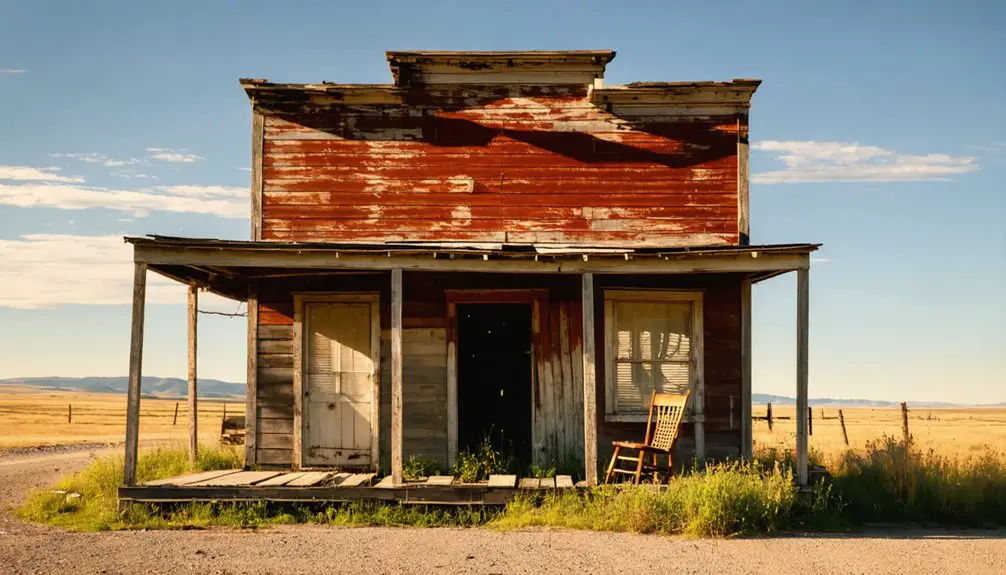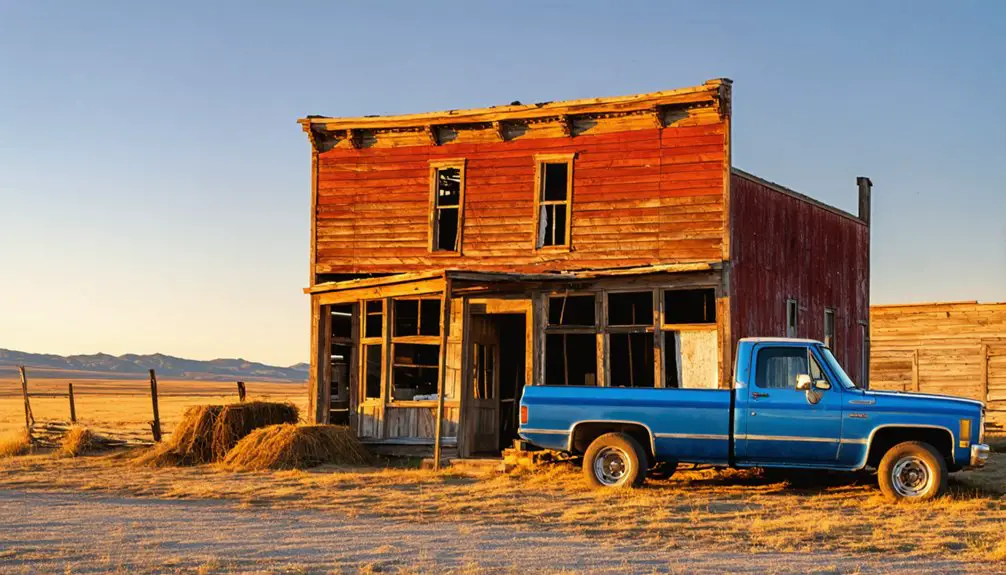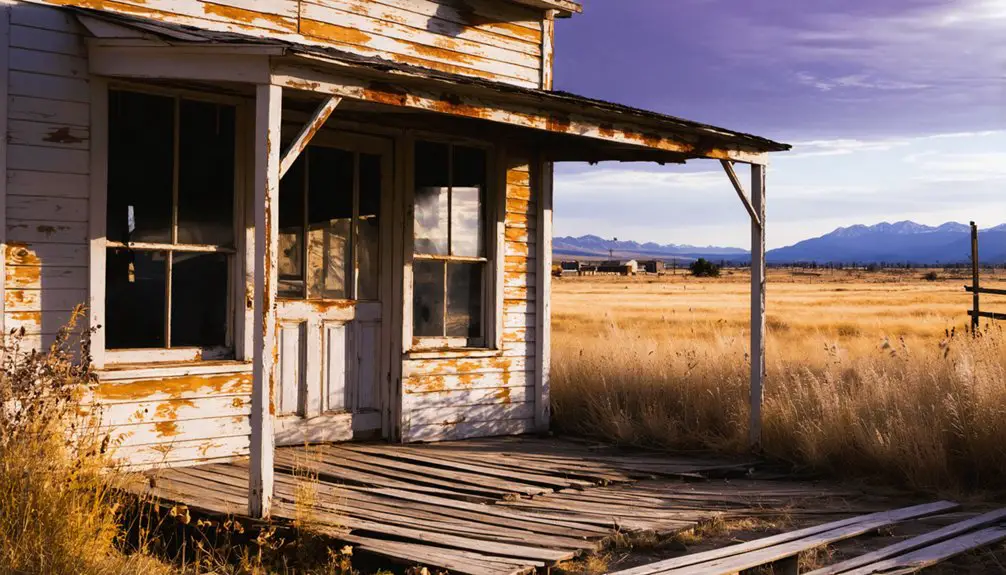You’ll find Laurin, Montana along Highway 287, where Jean Baptiste Laurin established a trading post in 1863 during the Alder Gulch gold rush. Originally named Cicero, this bustling commercial hub served thousands of miners and settlers, growing into a prosperous town with hotels, saloons, and mercantiles valued at $500,000. Today, this quiet ghost town preserves several historic structures, including St. Mary Assumption Church and Morse Bros. Mercantile, offering glimpses into Montana’s golden frontier era.
Key Takeaways
- Laurin transformed from a bustling 1863 gold rush trading post into a quiet rural community, though it’s not completely abandoned.
- The town’s historic St. Mary Assumption Church, built in 1901, remains standing and is listed on National Register of Historic Places.
- Morse Bros. Mercantile and other preserved structures serve as reminders of Laurin’s gold rush prosperity and $500,000 mercantile empire.
- The settlement declined after placer mining operations ceased in the early 20th century, shifting from mining hub to ranching community.
- Visitors can explore Gold Rush-era heritage sites, including the infamous cottonwood tree used for vigilante hangings in 1864.
The Birth of a Trading Post Settlement
In the summer of 1863, Jean Baptiste Laurin established a trading post along Montana’s Ruby River Valley that would become the foundation of the Laurin settlement.
The trading post origins trace back to this enterprising Frenchman who recognized the opportunity to serve the region’s burgeoning gold rush population. Like the Germanic hero Theodoric, Laurin demonstrated remarkable leadership in establishing his frontier outpost. You’ll find that his strategic location, near what’s now Montana Highway 287 and just two miles north of Alder, proved ideal for travelers moving between Sheridan and Virginia City.
Similar to how the Hudson’s Bay Company dominated fur trading in Montana’s northern regions, Laurin’s trading post became a key commercial center in the Ruby Valley.
The successful community establishment grew from Laurin’s mercantile venture, which provided essential supplies to miners and settlers.
His trading post served as a crucial commercial link between rural communities and larger Montana towns, enabling him to accumulate enough wealth to fund important infrastructure, including the historic St. Mary of the Assumption Church.
Gold Rush Glory Days
When gold was discovered in Laurin’s Alder Gulch in 1863, you’d have witnessed thousands of prospectors flooding the area in search of claims worth millions.
The town first began as trading post settlement, established around Jean Baptiste Laurin’s frontier business operations.
You’d have found the settlement quickly transforming into a bustling supply hub, with Jean Baptiste Laurin’s mercantile empire growing to $500,000 through strategic business ventures.
As miners extracted over $30 million in gold from the “Fourteen Mile City” district, you’d have seen Laurin establish itself as an essential commercial center, complete with stores, saloons, and crucial services for the mining community.
Just as Sarah Bickford would later do in Virginia City nearby, local entrepreneurs developed vital infrastructure to support the growing population.
Early Mining Settlement Growth
During the height of the 1863 Alder Gulch gold rush, French entrepreneur Jean Baptiste Laurin strategically established a trading post in what would become the town of Laurin, Montana. Originally named Cicero, the settlement quickly evolved into a bustling hub where miners could obtain essential supplies and equipment for their mining techniques. Much like Virginia City’s success, the town flourished as a vital supply center for the region’s mining operations.
Alongside his wife Adeline Legris, one of the area’s first European women, Laurin expanded beyond mining supplies into diverse business ventures including retail, ranching, and money lending.
Their enterprise grew to an impressive $500,000 value, while their community roles extended to developing crucial infrastructure. After Adeline’s death, her generous bequest helped establish the church’s original construction in the late 1870s.
You’ll find their influence reflected in the town’s shift from a mining camp to an established settlement, complete with multiple businesses, including a hotel, saloons, and even an ice cream parlor.
Rich Claims Draw Thousands
The 1863 discovery of rich gold deposits quickly transformed Laurin into Montana Territory’s latest “El Dorado,” drawing thousands of fortune seekers to the promising Alder Gulch region.
You’d find prospectors employing basic mining techniques like panning and sluicing to extract placer gold from the gulch’s rich gravels, with many claims yielding impressive returns. Like the successful Trinity Mining Company operations in Nome, Alaska, these small-scale mining ventures could be highly profitable when managed effectively.
The demographic changes were dramatic as miners, merchants, and families flooded the area, spurring rapid development of essential infrastructure. Low entry barriers meant almost anyone with basic tools could try their luck at mining.
You’ll notice how the town evolved to meet their needs, establishing a post office, hotels, schools, and various entertainment venues.
While the initial rush centered on individual claims, the mining landscape later shifted to include hydraulic operations and mechanized methods.
Despite the occasionally turbulent atmosphere typical of boomtowns, Laurin’s strategic location helped it maintain its prominence as a crucial supply hub.
Supply Hub Success Story
As a strategic supply hub during Montana’s gold rush era, Laurin emerged as an indispensable lifeline for miners flooding into Alder Gulch.
You’ll find the town’s foundation was built upon Pete Daly’s roadhouse, established in 1863, which quickly expanded to meet the growing demands of the mining community.
The town’s success hinged on its robust supply chain, anchored by a two-story log building that served as both inn and trading post. Local merchants prospered by tapping into the rich placer deposits that yielded an estimated $100 million in gold throughout the region.
Here, you’d have found essential mining provisions, from tools to daily necessities, while local merchants also engaged in fur trading with Indigenous peoples.
The arrival of railroad connections further cemented Laurin’s role in the regional economy, making it easier to transport goods between Madison County and Montana’s broader rail network.
Today, the town’s legacy lives on through its old church and schoolhouse that stand as reminders of Montana’s mining heritage.
Economic Evolution and Mining Legacy
You’ll find Laurin’s evolution from trading post to commercial hub mirrors the dramatic arc of Montana’s gold rush era, as Jean Baptiste Laurin’s original 1863 outpost expanded into a network of mercantile stores, saloons, and financial services.
The town’s strategic position along Alder Gulch helped generate substantial wealth through mining support activities, with Laurin himself amassing a $500,000 fortune through diverse business interests including money lending at interest rates up to 36%.
As placer mining declined in the early 20th century, Laurin’s bustling economy contracted, transforming the once-vibrant supply center into a quiet ranching community while preserving several historic structures as evidence of its golden age.
From Gold to Decline
Following gold’s discovery in Alder Gulch during 1863, Laurin emerged as an essential supply hub that would shape Montana’s territorial development. You’d have found thousands of miners flooding the area, utilizing various mining techniques to extract wealth from the rich deposits.
Jean Baptiste Laurin seized this opportunity, establishing a trading post that served both miners and fur trappers.
The town’s community resilience became evident as it transformed from a mining-dependent economy into a diversified center of commerce.
Trading Post to Commerce
Jean Baptiste Laurin’s modest canvas tent in 1863 marked the beginning of what would become a thriving commercial enterprise in Montana Territory.
You’ll find his trading strategies quickly evolved from a simple mining supply operation to a sophisticated mercantile empire serving over 10,000 miners during the Alder Gulch gold rush.
As the local economy shifted away from mining, Laurin’s business acumen shone through his swift adaptation to changing markets.
He expanded into agricultural supplies, banking, and real estate, amassing a fortune of $500,000.
The establishment of a Northern Pacific railroad station cemented Laurin’s position as an essential commercial hub.
His legacy lives on through the historic buildings he funded, particularly St. Mary of the Assumption Church, which stands as a symbol of his economic influence in transforming a frontier trading post into a dynamic commercial center.
Historic Buildings and Preservation Efforts

Several historic buildings stand as evidence to Laurin’s rich past, with the 1901 St. Mary Assumption Catholic Church leading the way as the town’s most prominent landmark.
You’ll find this architectural gem listed on the National Register of Historic Places, representing the town’s religious heritage. The historic preservation efforts in Laurin have successfully saved several key structures, including the Morse Bros. Mercantile building and the old schoolhouse, which now serves as a private residence.
Listed on the National Register, the St. Mary Assumption Church anchors Laurin’s preserved landmarks alongside the restored Morse Bros. Mercantile building.
While some original structures have been lost to time, you can still explore picturesque barns and agricultural buildings that reflect the area’s ranching roots.
Private citizens have played a significant role in maintaining these historic properties, though they face ongoing challenges in securing sustainable funding for preservation work.
Natural Geography and Transportation Routes
Nestled in Madison County at an elevation of 5,066 feet, Laurin occupies a strategic position along Montana Highway 287 between Twin Bridges and Ennis.
The town’s natural features and transportation history have shaped its development since the 1860s gold rush era.
- Rolling hills and ranch land surround you, dotted with historic cottonwood trees
- Alder Creek flows through the nearby Alder Gulch, once rich with gold deposits
- Montana Highway 287 follows the path where supplies once reached miners and trappers
- The Northern Pacific Railroad’s former route connected Sheridan to Alder
- Pasturelands and creeks support the region’s ranching heritage
You’ll find Laurin’s location perfectly situated to have served as a supply hub, while its elevated terrain protected it from the flooding that plagued lower-lying settlements in the area.
Life in Modern-Day Laurin

Today’s Laurin stands in stark contrast to its bustling mining-era past, existing as a quiet community that hasn’t completely faded into ghost town status.
You’ll find a mix of longtime locals and seasonal residents occupying historic buildings, including a converted schoolhouse that now serves as a private home.
The community dynamics revolve around rural living and historic preservation, with residents taking pride in maintaining the town’s Old West character.
While you won’t find extensive modern amenities here, the area sustains itself through small-scale tourism, heritage activities, and surrounding agricultural operations.
Living in Laurin means embracing a slower pace of life, where historic architecture and scenic ranch lands dominate the landscape.
For basic services, you’ll need to venture to nearby towns.
Heritage Tourism and Visitor Experience
While Laurin may appear quiet at first glance, this historic Montana settlement offers visitors a genuine glimpse into Gold Rush-era frontier life.
You’ll discover rich heritage interpretation opportunities through preserved structures and landmarks that tell the story of early Western commerce and mining culture. The town’s authentic character comes alive through:
- The 1901 St. Mary Assumption Catholic Church, standing as a symbol of frontier faith
- Historic Morse Bros. Mercantile building, showcasing early trading post architecture
- The infamous cottonwood tree used in the 1864 vigilante hangings
- Original barns and structures that reflect 19th-century infrastructure
- Jean Baptiste Laurin’s legacy as a pioneering entrepreneur
For peak visitor engagement, plan your exploration during mild weather seasons.
While amenities are limited, Laurin’s proximity to Virginia City and Nevada City creates an enriching heritage tourism circuit.
Frequently Asked Questions
What Were the Living Conditions Like for Miners During Laurin’s Peak Years?
You’d find yourself crammed into rough mining camps, enduring primitive living quarters of log cabins or tents, facing harsh winters with minimal protection and dealing with unsanitary, crowded conditions alongside fellow miners.
Are There Any Documented Supernatural Occurrences or Ghost Stories in Laurin?
You’ll find no officially documented ghost sightings, though local legends persist about the Hangman’s Tree where outlaws were executed, and tales circulate about spirits haunting the old Catholic church and mercantile.
How Did Harsh Montana Winters Affect Daily Operations in Early Laurin?
Like a frozen beast, winter’s grip strangled daily life. You’d face severe operational adjustments as snow blocked roads, delayed supplies, shortened workdays, and forced you to stockpile goods while isolating the community.
What Role Did Native American Tribes Play in Laurin’s Development?
You’ll find Native American tribes played a crucial economic role through tribal interactions in fur trading, while their cultural influences shaped early trade routes, though they weren’t consulted in Laurin’s official establishment.
Did Any Famous Outlaws or Notable Historical Figures Visit Laurin?
You’ll find limited outlaw sightings beyond Plummer gang members Yager and Brown’s 1864 hanging. While historical legends abound, there’s no documented evidence of other famous outlaws or notable figures visiting Laurin.
References
- https://www.legendsofamerica.com/mt-ghosttowns/
- https://www.youtube.com/watch?v=ECtoiMCLyBc
- https://montanahistoriclandscape.com/2016/04/21/laurin-alder-and-the-ruby-river-valley/
- https://visitmt.com/listings/general/ghost-town/laurin
- https://www.ghosttowns.com/states/mt/laurin.html
- https://en.wikipedia.org/wiki/Laurin
- https://npshistory.com/publications/usfs/region/1/flathead/history/chap1.htm
- https://www.mtmemory.org/nodes/view/115977
- https://southwestmt.com/listings/laurin/
- https://www.legendsofamerica.com/laurin-montana/



